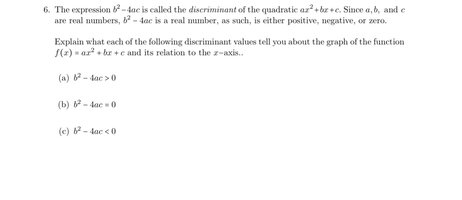I have question 6 attached to this, I’m honestly lost.
I think part a it has b^2-4ac has to positive because it’s greater than zero but I don’t know what to say about the function in relation to the x axis.
Part b b^2-4ac=0 wouldn’t the function be on the x axis only cause it’s = 0.
Part C b^2-4ac<0 it has to be negative so wouldn’t the function be below the x axis.
Otherwise I’m totally lost since there aren’t actual values given. Also I find this question to be worded weird.
I think part a it has b^2-4ac has to positive because it’s greater than zero but I don’t know what to say about the function in relation to the x axis.
Part b b^2-4ac=0 wouldn’t the function be on the x axis only cause it’s = 0.
Part C b^2-4ac<0 it has to be negative so wouldn’t the function be below the x axis.
Otherwise I’m totally lost since there aren’t actual values given. Also I find this question to be worded weird.

